Analyzing CSR and Sustainability in Management: IKEA Report
VerifiedAdded on 2020/05/28
|8
|2061
|99
Report
AI Summary
This report delves into the concepts of Corporate Social Responsibility (CSR) and sustainability, emphasizing their interconnectedness and importance in modern business. It defines CSR as an organization's commitment to activities that benefit society and highlights the significance of sustainability practices. The report uses IKEA as a case study, examining its sustainable strategies, including energy efficiency, sustainable product development, and supply chain management. It analyzes the stakeholder approach, focusing on how IKEA addresses the needs of its various stakeholders, such as customers, employees, and suppliers, to achieve both profitability and social responsibility. The report references theories like the triple bottom line theory to provide a comprehensive understanding of CSR and sustainable development within the context of a leading global company.
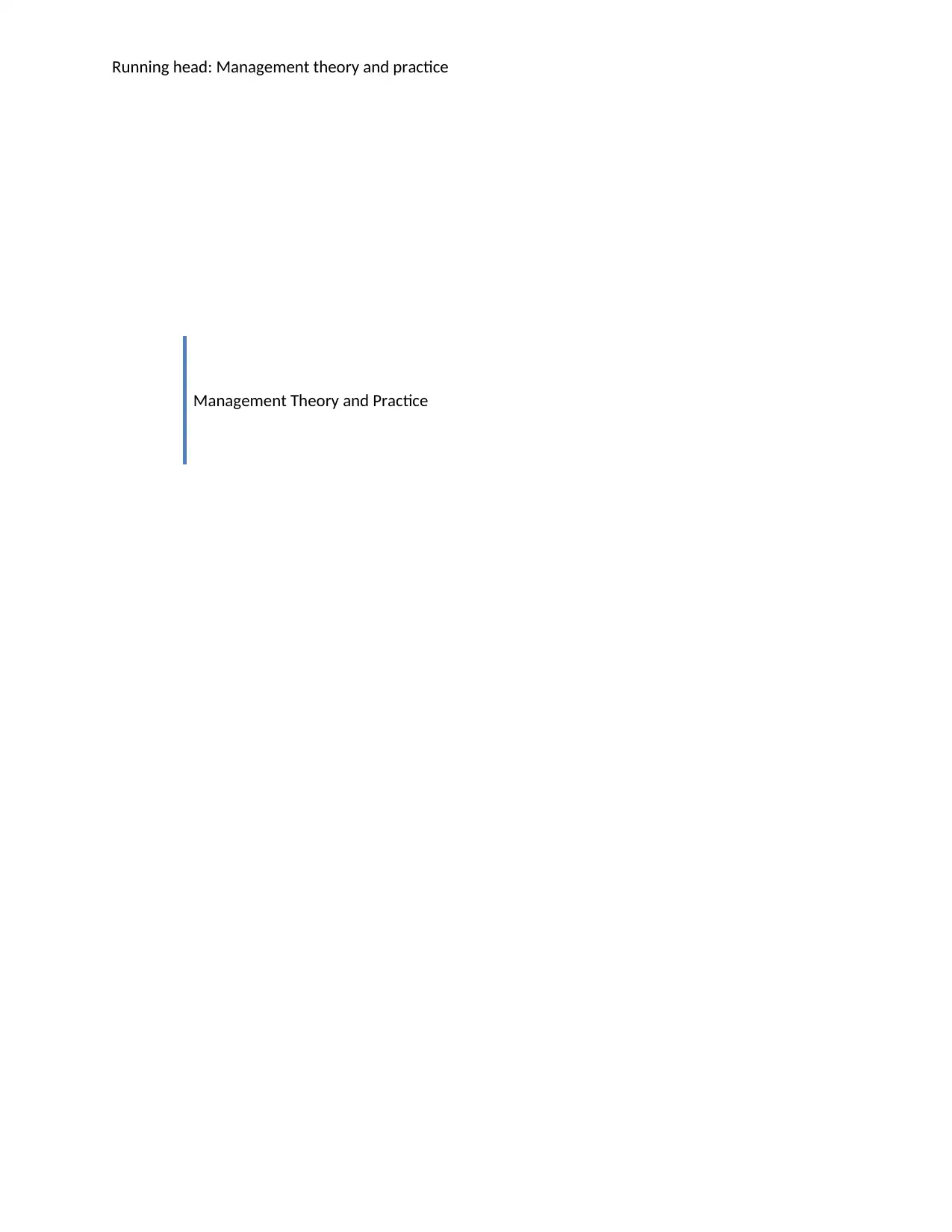
Running head: Management theory and practice
Management Theory and Practice
Management Theory and Practice
Paraphrase This Document
Need a fresh take? Get an instant paraphrase of this document with our AI Paraphraser
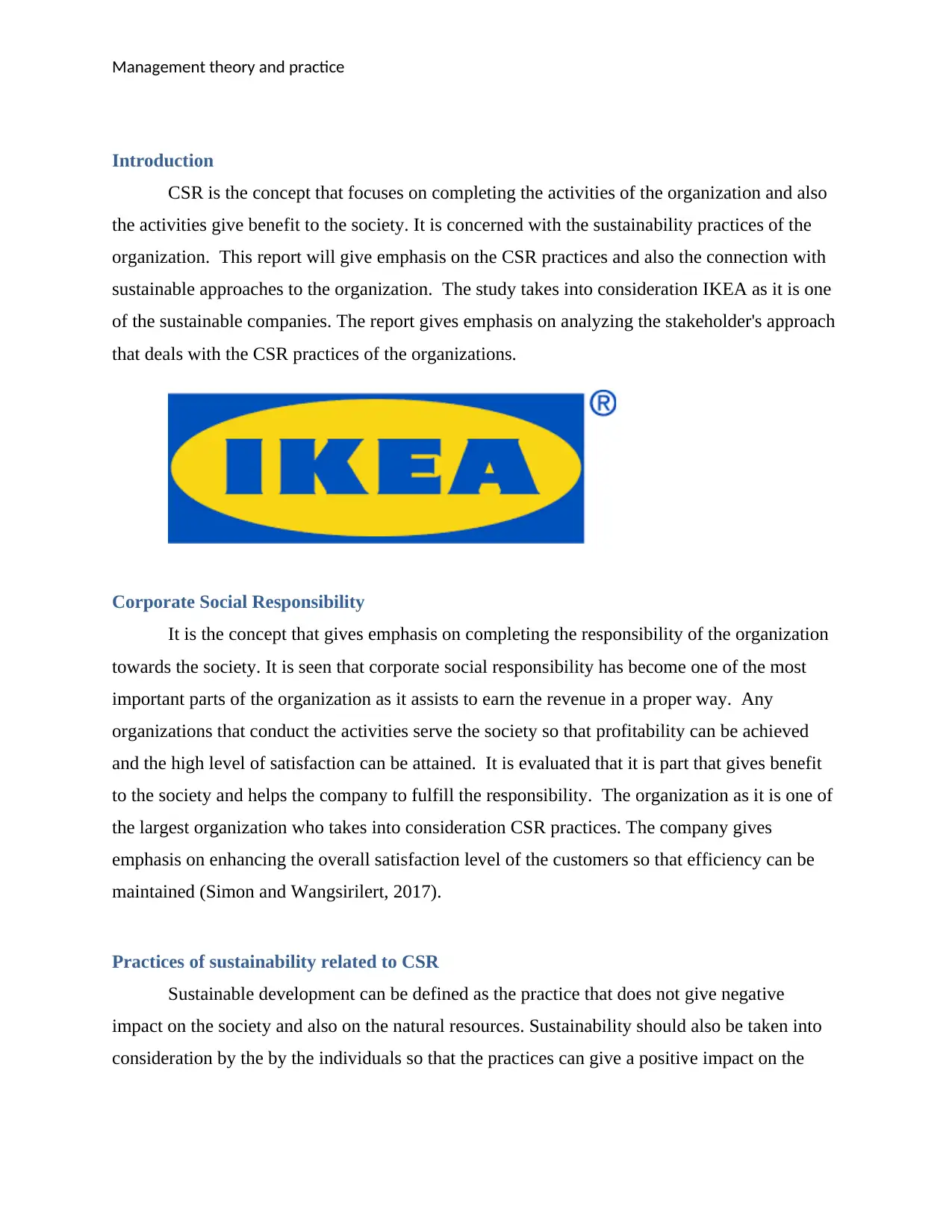
Management theory and practice
Introduction
CSR is the concept that focuses on completing the activities of the organization and also
the activities give benefit to the society. It is concerned with the sustainability practices of the
organization. This report will give emphasis on the CSR practices and also the connection with
sustainable approaches to the organization. The study takes into consideration IKEA as it is one
of the sustainable companies. The report gives emphasis on analyzing the stakeholder's approach
that deals with the CSR practices of the organizations.
Corporate Social Responsibility
It is the concept that gives emphasis on completing the responsibility of the organization
towards the society. It is seen that corporate social responsibility has become one of the most
important parts of the organization as it assists to earn the revenue in a proper way. Any
organizations that conduct the activities serve the society so that profitability can be achieved
and the high level of satisfaction can be attained. It is evaluated that it is part that gives benefit
to the society and helps the company to fulfill the responsibility. The organization as it is one of
the largest organization who takes into consideration CSR practices. The company gives
emphasis on enhancing the overall satisfaction level of the customers so that efficiency can be
maintained (Simon and Wangsirilert, 2017).
Practices of sustainability related to CSR
Sustainable development can be defined as the practice that does not give negative
impact on the society and also on the natural resources. Sustainability should also be taken into
consideration by the by the individuals so that the practices can give a positive impact on the
Introduction
CSR is the concept that focuses on completing the activities of the organization and also
the activities give benefit to the society. It is concerned with the sustainability practices of the
organization. This report will give emphasis on the CSR practices and also the connection with
sustainable approaches to the organization. The study takes into consideration IKEA as it is one
of the sustainable companies. The report gives emphasis on analyzing the stakeholder's approach
that deals with the CSR practices of the organizations.
Corporate Social Responsibility
It is the concept that gives emphasis on completing the responsibility of the organization
towards the society. It is seen that corporate social responsibility has become one of the most
important parts of the organization as it assists to earn the revenue in a proper way. Any
organizations that conduct the activities serve the society so that profitability can be achieved
and the high level of satisfaction can be attained. It is evaluated that it is part that gives benefit
to the society and helps the company to fulfill the responsibility. The organization as it is one of
the largest organization who takes into consideration CSR practices. The company gives
emphasis on enhancing the overall satisfaction level of the customers so that efficiency can be
maintained (Simon and Wangsirilert, 2017).
Practices of sustainability related to CSR
Sustainable development can be defined as the practice that does not give negative
impact on the society and also on the natural resources. Sustainability should also be taken into
consideration by the by the individuals so that the practices can give a positive impact on the
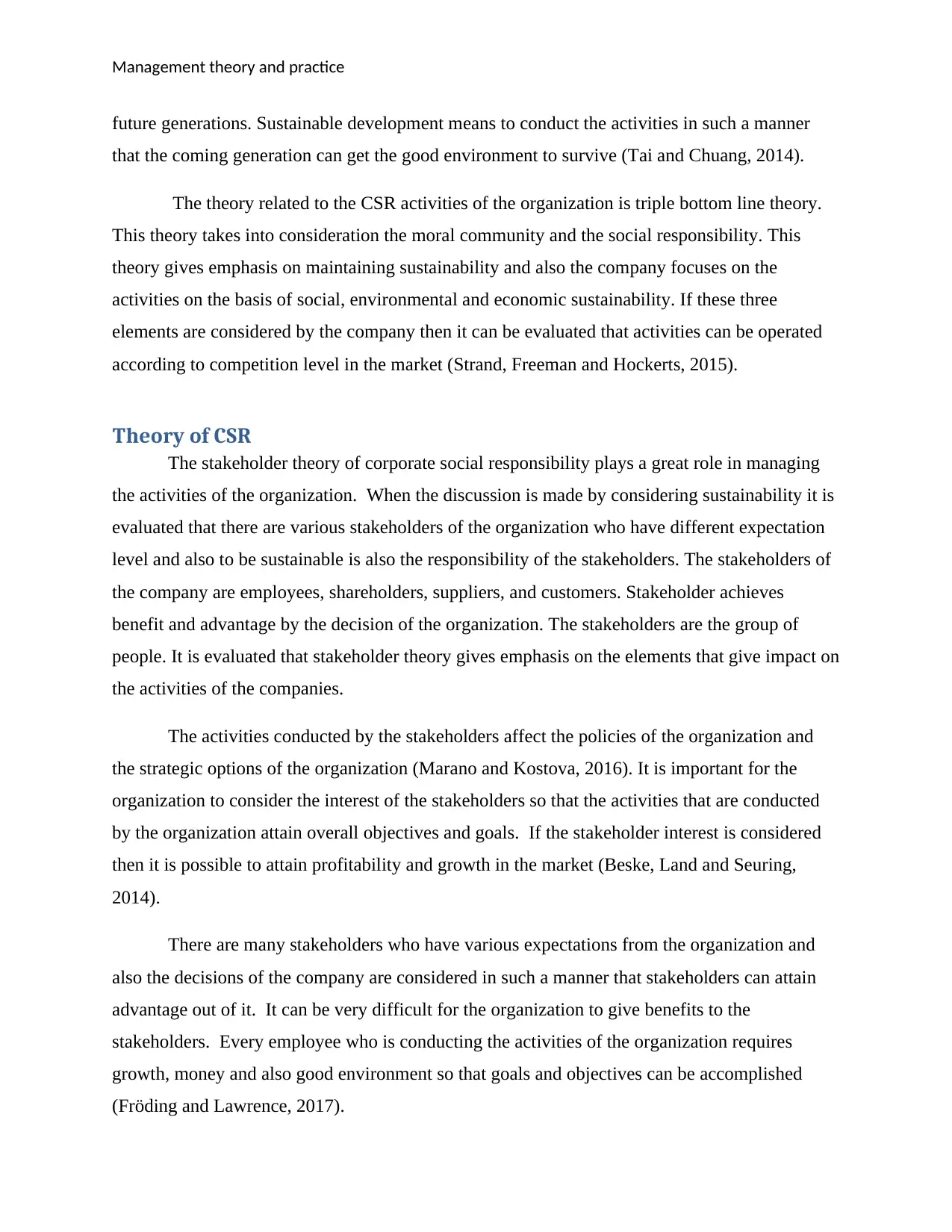
Management theory and practice
future generations. Sustainable development means to conduct the activities in such a manner
that the coming generation can get the good environment to survive (Tai and Chuang, 2014).
The theory related to the CSR activities of the organization is triple bottom line theory.
This theory takes into consideration the moral community and the social responsibility. This
theory gives emphasis on maintaining sustainability and also the company focuses on the
activities on the basis of social, environmental and economic sustainability. If these three
elements are considered by the company then it can be evaluated that activities can be operated
according to competition level in the market (Strand, Freeman and Hockerts, 2015).
Theory of CSR
The stakeholder theory of corporate social responsibility plays a great role in managing
the activities of the organization. When the discussion is made by considering sustainability it is
evaluated that there are various stakeholders of the organization who have different expectation
level and also to be sustainable is also the responsibility of the stakeholders. The stakeholders of
the company are employees, shareholders, suppliers, and customers. Stakeholder achieves
benefit and advantage by the decision of the organization. The stakeholders are the group of
people. It is evaluated that stakeholder theory gives emphasis on the elements that give impact on
the activities of the companies.
The activities conducted by the stakeholders affect the policies of the organization and
the strategic options of the organization (Marano and Kostova, 2016). It is important for the
organization to consider the interest of the stakeholders so that the activities that are conducted
by the organization attain overall objectives and goals. If the stakeholder interest is considered
then it is possible to attain profitability and growth in the market (Beske, Land and Seuring,
2014).
There are many stakeholders who have various expectations from the organization and
also the decisions of the company are considered in such a manner that stakeholders can attain
advantage out of it. It can be very difficult for the organization to give benefits to the
stakeholders. Every employee who is conducting the activities of the organization requires
growth, money and also good environment so that goals and objectives can be accomplished
(Fröding and Lawrence, 2017).
future generations. Sustainable development means to conduct the activities in such a manner
that the coming generation can get the good environment to survive (Tai and Chuang, 2014).
The theory related to the CSR activities of the organization is triple bottom line theory.
This theory takes into consideration the moral community and the social responsibility. This
theory gives emphasis on maintaining sustainability and also the company focuses on the
activities on the basis of social, environmental and economic sustainability. If these three
elements are considered by the company then it can be evaluated that activities can be operated
according to competition level in the market (Strand, Freeman and Hockerts, 2015).
Theory of CSR
The stakeholder theory of corporate social responsibility plays a great role in managing
the activities of the organization. When the discussion is made by considering sustainability it is
evaluated that there are various stakeholders of the organization who have different expectation
level and also to be sustainable is also the responsibility of the stakeholders. The stakeholders of
the company are employees, shareholders, suppliers, and customers. Stakeholder achieves
benefit and advantage by the decision of the organization. The stakeholders are the group of
people. It is evaluated that stakeholder theory gives emphasis on the elements that give impact on
the activities of the companies.
The activities conducted by the stakeholders affect the policies of the organization and
the strategic options of the organization (Marano and Kostova, 2016). It is important for the
organization to consider the interest of the stakeholders so that the activities that are conducted
by the organization attain overall objectives and goals. If the stakeholder interest is considered
then it is possible to attain profitability and growth in the market (Beske, Land and Seuring,
2014).
There are many stakeholders who have various expectations from the organization and
also the decisions of the company are considered in such a manner that stakeholders can attain
advantage out of it. It can be very difficult for the organization to give benefits to the
stakeholders. Every employee who is conducting the activities of the organization requires
growth, money and also good environment so that goals and objectives can be accomplished
(Fröding and Lawrence, 2017).
⊘ This is a preview!⊘
Do you want full access?
Subscribe today to unlock all pages.

Trusted by 1+ million students worldwide
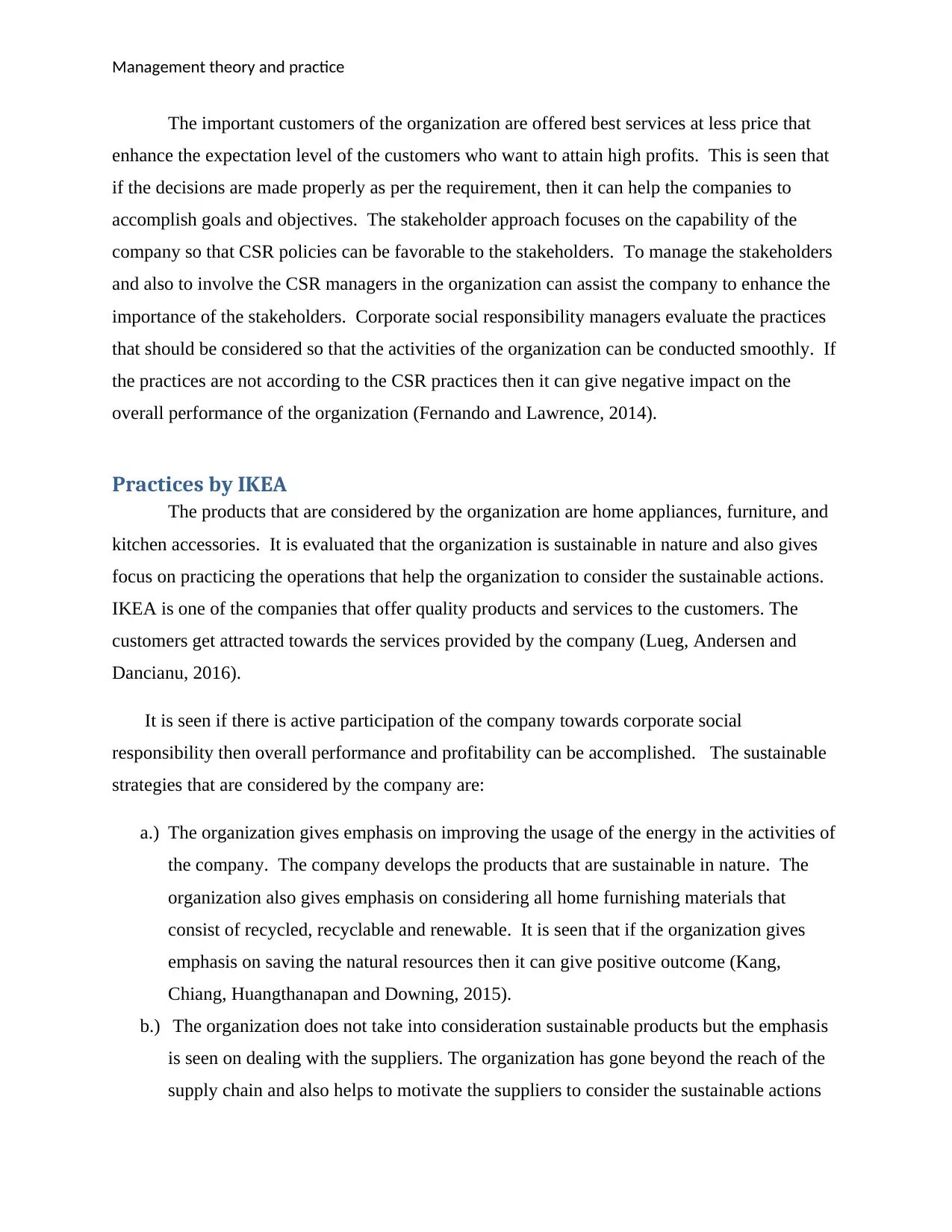
Management theory and practice
The important customers of the organization are offered best services at less price that
enhance the expectation level of the customers who want to attain high profits. This is seen that
if the decisions are made properly as per the requirement, then it can help the companies to
accomplish goals and objectives. The stakeholder approach focuses on the capability of the
company so that CSR policies can be favorable to the stakeholders. To manage the stakeholders
and also to involve the CSR managers in the organization can assist the company to enhance the
importance of the stakeholders. Corporate social responsibility managers evaluate the practices
that should be considered so that the activities of the organization can be conducted smoothly. If
the practices are not according to the CSR practices then it can give negative impact on the
overall performance of the organization (Fernando and Lawrence, 2014).
Practices by IKEA
The products that are considered by the organization are home appliances, furniture, and
kitchen accessories. It is evaluated that the organization is sustainable in nature and also gives
focus on practicing the operations that help the organization to consider the sustainable actions.
IKEA is one of the companies that offer quality products and services to the customers. The
customers get attracted towards the services provided by the company (Lueg, Andersen and
Dancianu, 2016).
It is seen if there is active participation of the company towards corporate social
responsibility then overall performance and profitability can be accomplished. The sustainable
strategies that are considered by the company are:
a.) The organization gives emphasis on improving the usage of the energy in the activities of
the company. The company develops the products that are sustainable in nature. The
organization also gives emphasis on considering all home furnishing materials that
consist of recycled, recyclable and renewable. It is seen that if the organization gives
emphasis on saving the natural resources then it can give positive outcome (Kang,
Chiang, Huangthanapan and Downing, 2015).
b.) The organization does not take into consideration sustainable products but the emphasis
is seen on dealing with the suppliers. The organization has gone beyond the reach of the
supply chain and also helps to motivate the suppliers to consider the sustainable actions
The important customers of the organization are offered best services at less price that
enhance the expectation level of the customers who want to attain high profits. This is seen that
if the decisions are made properly as per the requirement, then it can help the companies to
accomplish goals and objectives. The stakeholder approach focuses on the capability of the
company so that CSR policies can be favorable to the stakeholders. To manage the stakeholders
and also to involve the CSR managers in the organization can assist the company to enhance the
importance of the stakeholders. Corporate social responsibility managers evaluate the practices
that should be considered so that the activities of the organization can be conducted smoothly. If
the practices are not according to the CSR practices then it can give negative impact on the
overall performance of the organization (Fernando and Lawrence, 2014).
Practices by IKEA
The products that are considered by the organization are home appliances, furniture, and
kitchen accessories. It is evaluated that the organization is sustainable in nature and also gives
focus on practicing the operations that help the organization to consider the sustainable actions.
IKEA is one of the companies that offer quality products and services to the customers. The
customers get attracted towards the services provided by the company (Lueg, Andersen and
Dancianu, 2016).
It is seen if there is active participation of the company towards corporate social
responsibility then overall performance and profitability can be accomplished. The sustainable
strategies that are considered by the company are:
a.) The organization gives emphasis on improving the usage of the energy in the activities of
the company. The company develops the products that are sustainable in nature. The
organization also gives emphasis on considering all home furnishing materials that
consist of recycled, recyclable and renewable. It is seen that if the organization gives
emphasis on saving the natural resources then it can give positive outcome (Kang,
Chiang, Huangthanapan and Downing, 2015).
b.) The organization does not take into consideration sustainable products but the emphasis
is seen on dealing with the suppliers. The organization has gone beyond the reach of the
supply chain and also helps to motivate the suppliers to consider the sustainable actions
Paraphrase This Document
Need a fresh take? Get an instant paraphrase of this document with our AI Paraphraser
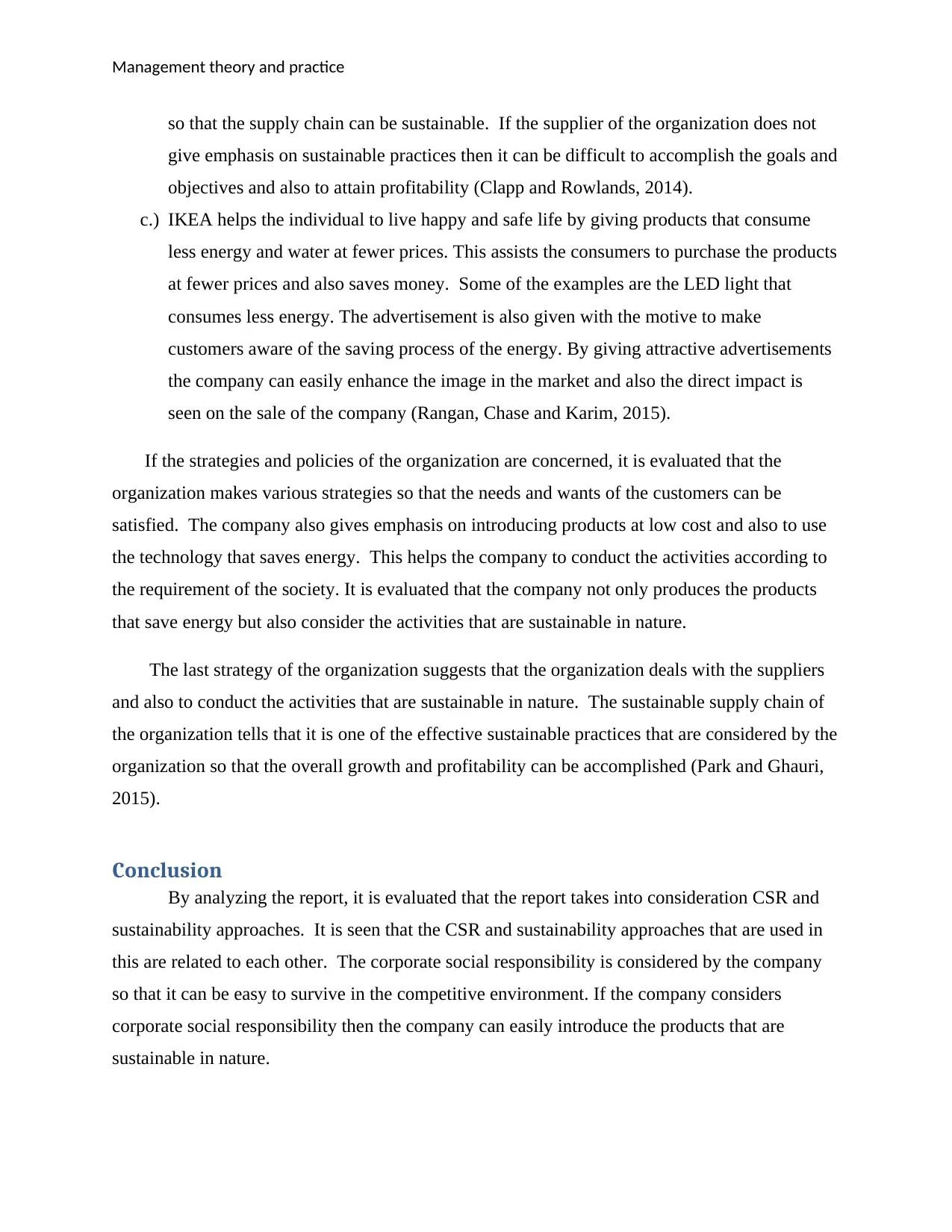
Management theory and practice
so that the supply chain can be sustainable. If the supplier of the organization does not
give emphasis on sustainable practices then it can be difficult to accomplish the goals and
objectives and also to attain profitability (Clapp and Rowlands, 2014).
c.) IKEA helps the individual to live happy and safe life by giving products that consume
less energy and water at fewer prices. This assists the consumers to purchase the products
at fewer prices and also saves money. Some of the examples are the LED light that
consumes less energy. The advertisement is also given with the motive to make
customers aware of the saving process of the energy. By giving attractive advertisements
the company can easily enhance the image in the market and also the direct impact is
seen on the sale of the company (Rangan, Chase and Karim, 2015).
If the strategies and policies of the organization are concerned, it is evaluated that the
organization makes various strategies so that the needs and wants of the customers can be
satisfied. The company also gives emphasis on introducing products at low cost and also to use
the technology that saves energy. This helps the company to conduct the activities according to
the requirement of the society. It is evaluated that the company not only produces the products
that save energy but also consider the activities that are sustainable in nature.
The last strategy of the organization suggests that the organization deals with the suppliers
and also to conduct the activities that are sustainable in nature. The sustainable supply chain of
the organization tells that it is one of the effective sustainable practices that are considered by the
organization so that the overall growth and profitability can be accomplished (Park and Ghauri,
2015).
Conclusion
By analyzing the report, it is evaluated that the report takes into consideration CSR and
sustainability approaches. It is seen that the CSR and sustainability approaches that are used in
this are related to each other. The corporate social responsibility is considered by the company
so that it can be easy to survive in the competitive environment. If the company considers
corporate social responsibility then the company can easily introduce the products that are
sustainable in nature.
so that the supply chain can be sustainable. If the supplier of the organization does not
give emphasis on sustainable practices then it can be difficult to accomplish the goals and
objectives and also to attain profitability (Clapp and Rowlands, 2014).
c.) IKEA helps the individual to live happy and safe life by giving products that consume
less energy and water at fewer prices. This assists the consumers to purchase the products
at fewer prices and also saves money. Some of the examples are the LED light that
consumes less energy. The advertisement is also given with the motive to make
customers aware of the saving process of the energy. By giving attractive advertisements
the company can easily enhance the image in the market and also the direct impact is
seen on the sale of the company (Rangan, Chase and Karim, 2015).
If the strategies and policies of the organization are concerned, it is evaluated that the
organization makes various strategies so that the needs and wants of the customers can be
satisfied. The company also gives emphasis on introducing products at low cost and also to use
the technology that saves energy. This helps the company to conduct the activities according to
the requirement of the society. It is evaluated that the company not only produces the products
that save energy but also consider the activities that are sustainable in nature.
The last strategy of the organization suggests that the organization deals with the suppliers
and also to conduct the activities that are sustainable in nature. The sustainable supply chain of
the organization tells that it is one of the effective sustainable practices that are considered by the
organization so that the overall growth and profitability can be accomplished (Park and Ghauri,
2015).
Conclusion
By analyzing the report, it is evaluated that the report takes into consideration CSR and
sustainability approaches. It is seen that the CSR and sustainability approaches that are used in
this are related to each other. The corporate social responsibility is considered by the company
so that it can be easy to survive in the competitive environment. If the company considers
corporate social responsibility then the company can easily introduce the products that are
sustainable in nature.
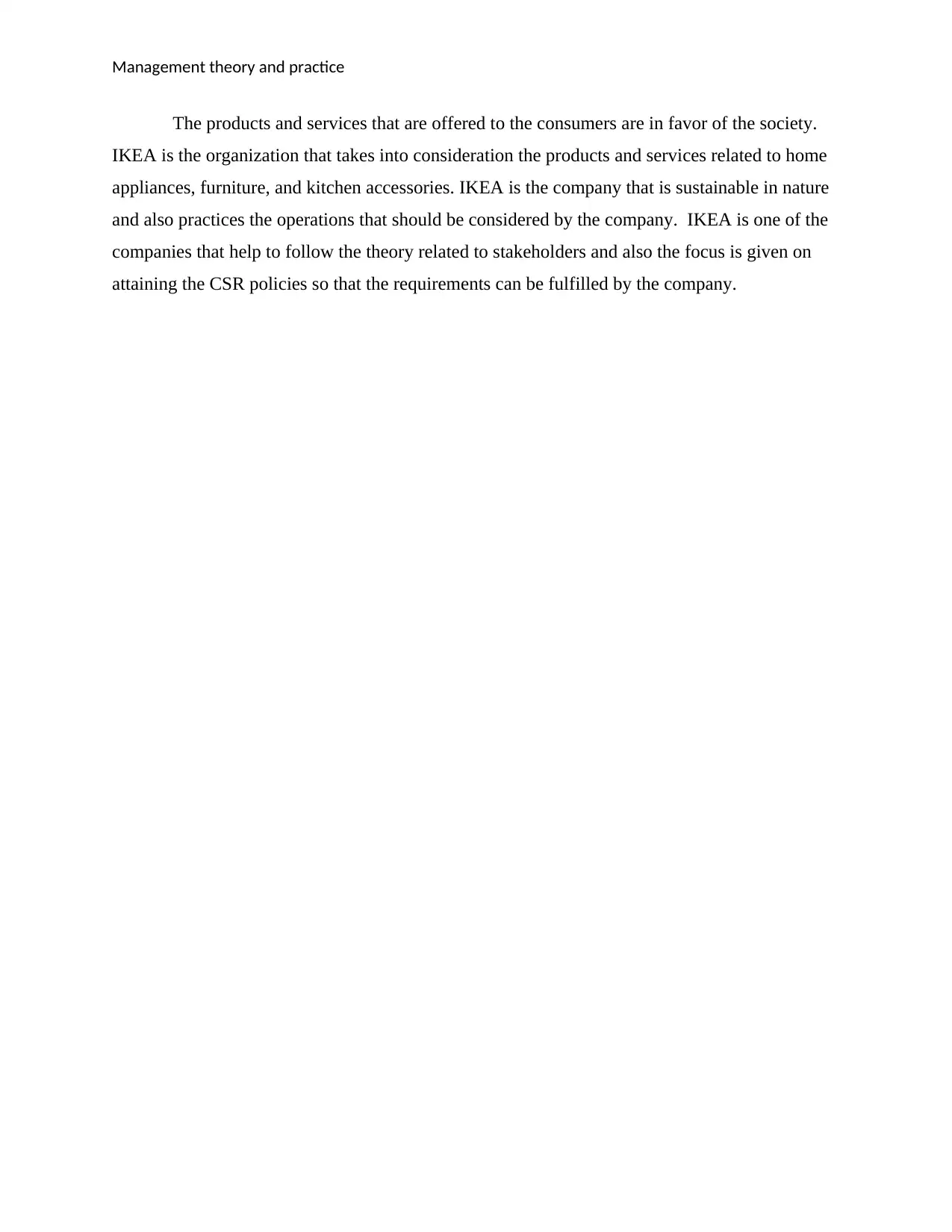
Management theory and practice
The products and services that are offered to the consumers are in favor of the society.
IKEA is the organization that takes into consideration the products and services related to home
appliances, furniture, and kitchen accessories. IKEA is the company that is sustainable in nature
and also practices the operations that should be considered by the company. IKEA is one of the
companies that help to follow the theory related to stakeholders and also the focus is given on
attaining the CSR policies so that the requirements can be fulfilled by the company.
The products and services that are offered to the consumers are in favor of the society.
IKEA is the organization that takes into consideration the products and services related to home
appliances, furniture, and kitchen accessories. IKEA is the company that is sustainable in nature
and also practices the operations that should be considered by the company. IKEA is one of the
companies that help to follow the theory related to stakeholders and also the focus is given on
attaining the CSR policies so that the requirements can be fulfilled by the company.
⊘ This is a preview!⊘
Do you want full access?
Subscribe today to unlock all pages.

Trusted by 1+ million students worldwide
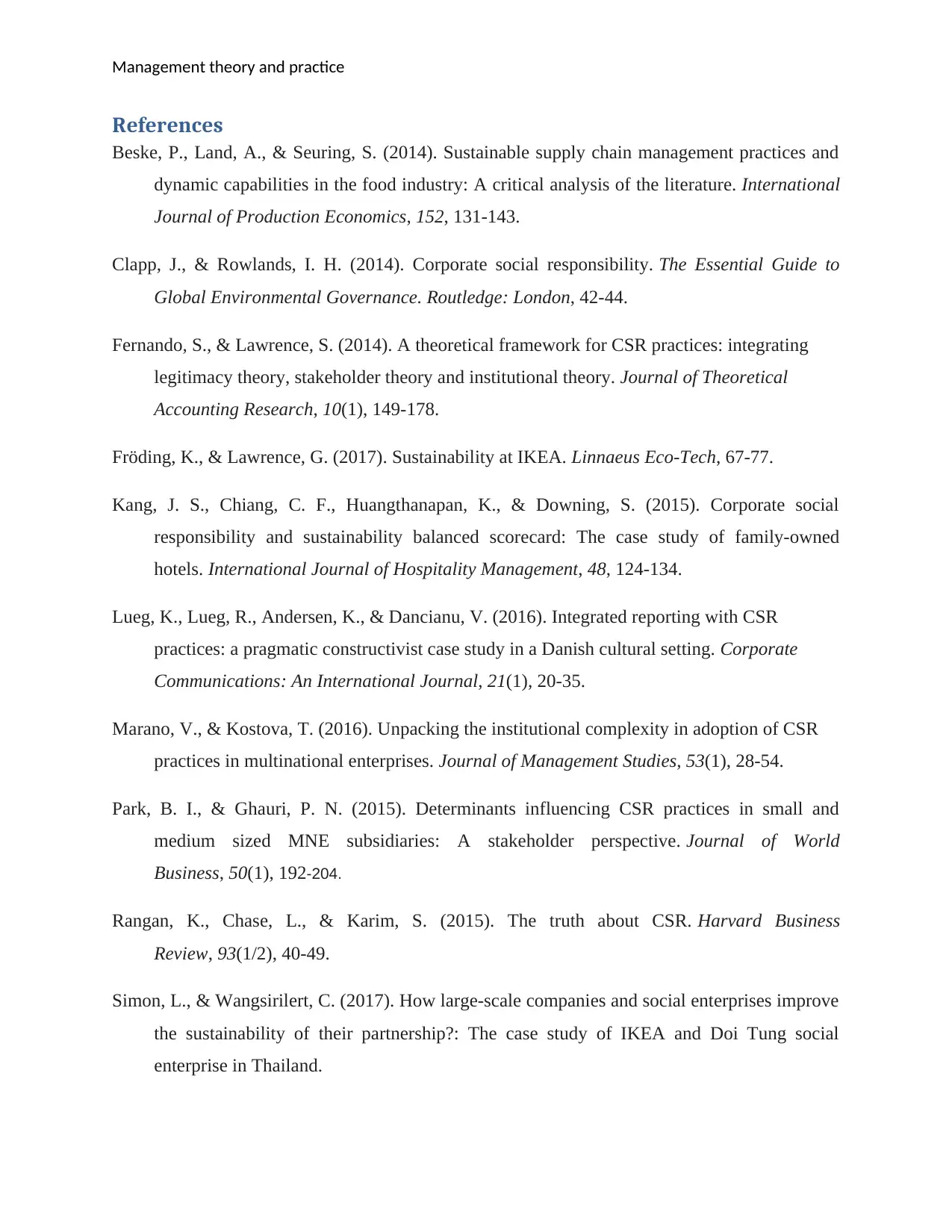
Management theory and practice
References
Beske, P., Land, A., & Seuring, S. (2014). Sustainable supply chain management practices and
dynamic capabilities in the food industry: A critical analysis of the literature. International
Journal of Production Economics, 152, 131-143.
Clapp, J., & Rowlands, I. H. (2014). Corporate social responsibility. The Essential Guide to
Global Environmental Governance. Routledge: London, 42-44.
Fernando, S., & Lawrence, S. (2014). A theoretical framework for CSR practices: integrating
legitimacy theory, stakeholder theory and institutional theory. Journal of Theoretical
Accounting Research, 10(1), 149-178.
Fröding, K., & Lawrence, G. (2017). Sustainability at IKEA. Linnaeus Eco-Tech, 67-77.
Kang, J. S., Chiang, C. F., Huangthanapan, K., & Downing, S. (2015). Corporate social
responsibility and sustainability balanced scorecard: The case study of family-owned
hotels. International Journal of Hospitality Management, 48, 124-134.
Lueg, K., Lueg, R., Andersen, K., & Dancianu, V. (2016). Integrated reporting with CSR
practices: a pragmatic constructivist case study in a Danish cultural setting. Corporate
Communications: An International Journal, 21(1), 20-35.
Marano, V., & Kostova, T. (2016). Unpacking the institutional complexity in adoption of CSR
practices in multinational enterprises. Journal of Management Studies, 53(1), 28-54.
Park, B. I., & Ghauri, P. N. (2015). Determinants influencing CSR practices in small and
medium sized MNE subsidiaries: A stakeholder perspective. Journal of World
Business, 50(1), 192-204.
Rangan, K., Chase, L., & Karim, S. (2015). The truth about CSR. Harvard Business
Review, 93(1/2), 40-49.
Simon, L., & Wangsirilert, C. (2017). How large-scale companies and social enterprises improve
the sustainability of their partnership?: The case study of IKEA and Doi Tung social
enterprise in Thailand.
References
Beske, P., Land, A., & Seuring, S. (2014). Sustainable supply chain management practices and
dynamic capabilities in the food industry: A critical analysis of the literature. International
Journal of Production Economics, 152, 131-143.
Clapp, J., & Rowlands, I. H. (2014). Corporate social responsibility. The Essential Guide to
Global Environmental Governance. Routledge: London, 42-44.
Fernando, S., & Lawrence, S. (2014). A theoretical framework for CSR practices: integrating
legitimacy theory, stakeholder theory and institutional theory. Journal of Theoretical
Accounting Research, 10(1), 149-178.
Fröding, K., & Lawrence, G. (2017). Sustainability at IKEA. Linnaeus Eco-Tech, 67-77.
Kang, J. S., Chiang, C. F., Huangthanapan, K., & Downing, S. (2015). Corporate social
responsibility and sustainability balanced scorecard: The case study of family-owned
hotels. International Journal of Hospitality Management, 48, 124-134.
Lueg, K., Lueg, R., Andersen, K., & Dancianu, V. (2016). Integrated reporting with CSR
practices: a pragmatic constructivist case study in a Danish cultural setting. Corporate
Communications: An International Journal, 21(1), 20-35.
Marano, V., & Kostova, T. (2016). Unpacking the institutional complexity in adoption of CSR
practices in multinational enterprises. Journal of Management Studies, 53(1), 28-54.
Park, B. I., & Ghauri, P. N. (2015). Determinants influencing CSR practices in small and
medium sized MNE subsidiaries: A stakeholder perspective. Journal of World
Business, 50(1), 192-204.
Rangan, K., Chase, L., & Karim, S. (2015). The truth about CSR. Harvard Business
Review, 93(1/2), 40-49.
Simon, L., & Wangsirilert, C. (2017). How large-scale companies and social enterprises improve
the sustainability of their partnership?: The case study of IKEA and Doi Tung social
enterprise in Thailand.
Paraphrase This Document
Need a fresh take? Get an instant paraphrase of this document with our AI Paraphraser
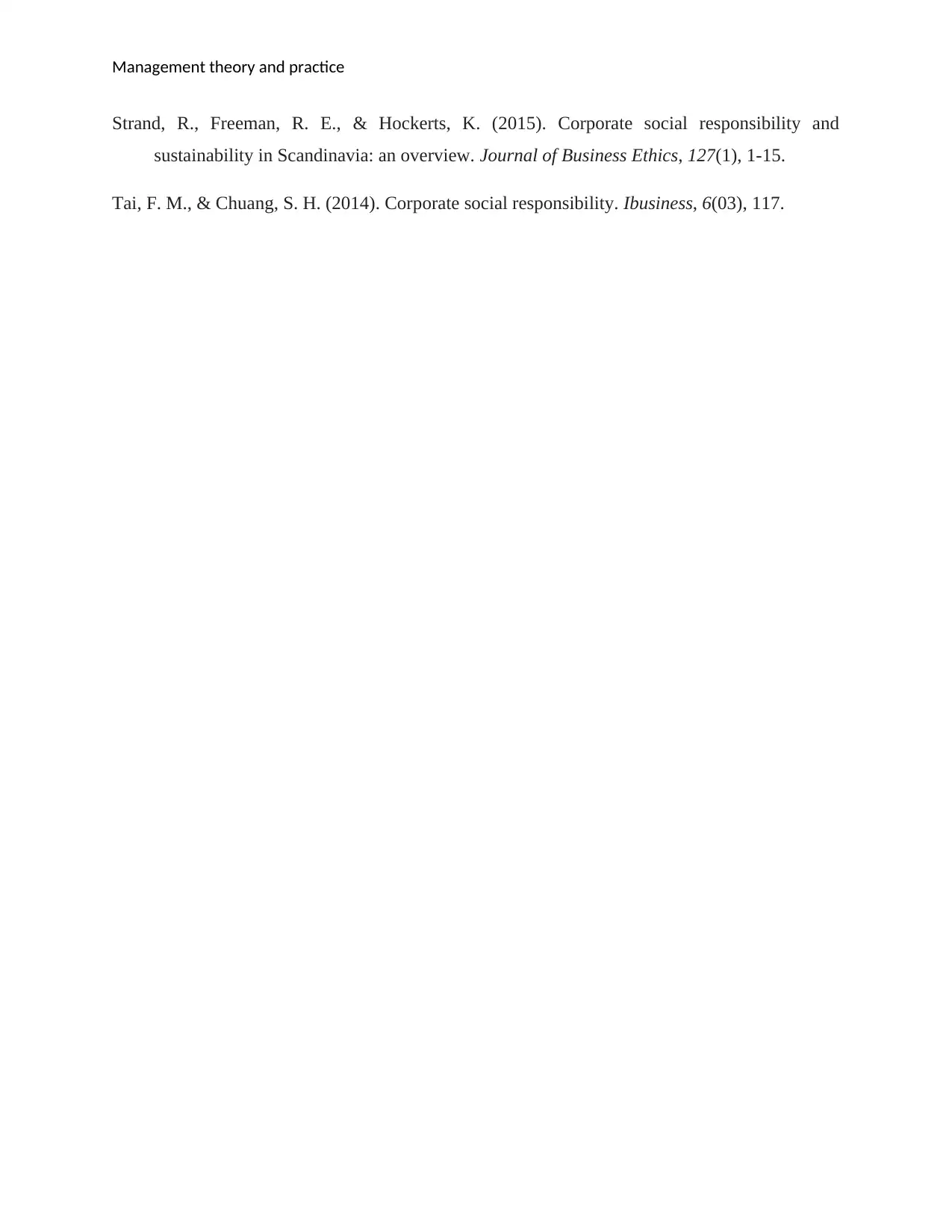
Management theory and practice
Strand, R., Freeman, R. E., & Hockerts, K. (2015). Corporate social responsibility and
sustainability in Scandinavia: an overview. Journal of Business Ethics, 127(1), 1-15.
Tai, F. M., & Chuang, S. H. (2014). Corporate social responsibility. Ibusiness, 6(03), 117.
Strand, R., Freeman, R. E., & Hockerts, K. (2015). Corporate social responsibility and
sustainability in Scandinavia: an overview. Journal of Business Ethics, 127(1), 1-15.
Tai, F. M., & Chuang, S. H. (2014). Corporate social responsibility. Ibusiness, 6(03), 117.
1 out of 8
Related Documents
Your All-in-One AI-Powered Toolkit for Academic Success.
+13062052269
info@desklib.com
Available 24*7 on WhatsApp / Email
![[object Object]](/_next/static/media/star-bottom.7253800d.svg)
Unlock your academic potential
Copyright © 2020–2025 A2Z Services. All Rights Reserved. Developed and managed by ZUCOL.





